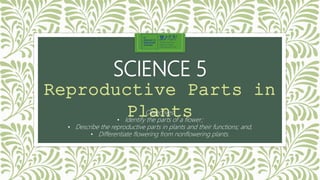Reroductive parts in Plants
•Als PPTX, PDF herunterladen•
0 gefällt mir•67 views
This document discusses the reproductive parts of plants. It defines flowering and non-flowering plants, with flowering plants bearing flowers that develop into fruits or seeds, while non-flowering plants produce seeds but no flowers. The parts of a flower are then described, including the pistil and stamen, which are the female and male reproductive parts, as well as other structures like the receptacle, sepals, and petals. Different types of flowers like perfect, imperfect, complete and incomplete are also defined.
Melden
Teilen
Melden
Teilen

Empfohlen
Introduction to flower, it's parts and types of flowers.

Introduction to flower, it's parts and types of flowers.Sindh Agriculture University Tandojam, Sindh Pakistan
Empfohlen
Introduction to flower, it's parts and types of flowers.

Introduction to flower, it's parts and types of flowers.Sindh Agriculture University Tandojam, Sindh Pakistan
Weitere ähnliche Inhalte
Was ist angesagt?
Was ist angesagt? (19)
Ähnlich wie Reroductive parts in Plants
Ähnlich wie Reroductive parts in Plants (20)
Pollination and fertilization in plant breeding (age6110

Pollination and fertilization in plant breeding (age6110
Mehr von irvingrei gamit
Mehr von irvingrei gamit (16)
MATH 4 PPT Q3 W4 - Lesson 52 - Quadrilateral 2.pptx

MATH 4 PPT Q3 W4 - Lesson 52 - Quadrilateral 2.pptx
1pp_TLE_roles and responsibility of entrepreneurship.pptx

1pp_TLE_roles and responsibility of entrepreneurship.pptx
W7 Kultura at paniniwala ng sinaunang Pilipino.pptx

W7 Kultura at paniniwala ng sinaunang Pilipino.pptx
W8_PP_Mathematics_Comparing dissimilar and Similar Fraction.pptx

W8_PP_Mathematics_Comparing dissimilar and Similar Fraction.pptx
Kürzlich hochgeladen
+971581248768>> SAFE AND ORIGINAL ABORTION PILLS FOR SALE IN DUBAI AND ABUDHA...

+971581248768>> SAFE AND ORIGINAL ABORTION PILLS FOR SALE IN DUBAI AND ABUDHA...?#DUbAI#??##{{(☎️+971_581248768%)**%*]'#abortion pills for sale in dubai@
Kürzlich hochgeladen (20)
THE ROLE OF BIOTECHNOLOGY IN THE ECONOMIC UPLIFT.pptx

THE ROLE OF BIOTECHNOLOGY IN THE ECONOMIC UPLIFT.pptx
Bhiwandi Bhiwandi ❤CALL GIRL 7870993772 ❤CALL GIRLS ESCORT SERVICE In Bhiwan...

Bhiwandi Bhiwandi ❤CALL GIRL 7870993772 ❤CALL GIRLS ESCORT SERVICE In Bhiwan...
Porella : features, morphology, anatomy, reproduction etc.

Porella : features, morphology, anatomy, reproduction etc.
+971581248768>> SAFE AND ORIGINAL ABORTION PILLS FOR SALE IN DUBAI AND ABUDHA...

+971581248768>> SAFE AND ORIGINAL ABORTION PILLS FOR SALE IN DUBAI AND ABUDHA...
Thyroid Physiology_Dr.E. Muralinath_ Associate Professor

Thyroid Physiology_Dr.E. Muralinath_ Associate Professor
TransientOffsetin14CAftertheCarringtonEventRecordedbyPolarTreeRings

TransientOffsetin14CAftertheCarringtonEventRecordedbyPolarTreeRings
Climate Change Impacts on Terrestrial and Aquatic Ecosystems.pptx

Climate Change Impacts on Terrestrial and Aquatic Ecosystems.pptx
Call Girls Ahmedabad +917728919243 call me Independent Escort Service

Call Girls Ahmedabad +917728919243 call me Independent Escort Service
LUNULARIA -features, morphology, anatomy ,reproduction etc.

LUNULARIA -features, morphology, anatomy ,reproduction etc.
Gwalior ❤CALL GIRL 84099*07087 ❤CALL GIRLS IN Gwalior ESCORT SERVICE❤CALL GIRL

Gwalior ❤CALL GIRL 84099*07087 ❤CALL GIRLS IN Gwalior ESCORT SERVICE❤CALL GIRL
development of diagnostic enzyme assay to detect leuser virus

development of diagnostic enzyme assay to detect leuser virus
Human & Veterinary Respiratory Physilogy_DR.E.Muralinath_Associate Professor....

Human & Veterinary Respiratory Physilogy_DR.E.Muralinath_Associate Professor....
Genetics and epigenetics of ADHD and comorbid conditions

Genetics and epigenetics of ADHD and comorbid conditions
Reroductive parts in Plants
- 1. SCIENCE 5 Reproductive Parts in Plants Objectives: • Identify the parts of a flower; • Describe the reproductive parts in plants and their functions; and, • Differentiate flowering from nonflowering plants.
- 3. Flowering Plants • They bear flowers that eventually develop into fruits or seeds. • Most flowers are both male and female. • They attract pollinators with their color and fragrance.
- 4. Non Flowering Plants • They produce seeds but do not bear flowers. Examples are: Conifers, Cycads, Gingkos
- 6. Parts of the Flower
- 7. Pistil It is a female reproductive part. It has four parts namely: • Stigma – Catches pollen grains • Style – Long tube that attaches the stigma to ovary • Ovaries – Storage place of egg cell • Ovules – The egg cell of plants
- 8. Stamen •It is composed of anther and filament. Anther – It is responsible of producing pollen. Filament – It is the structure that supports the anther.
- 9. Other Structures For Support Of The Flowers •Receptacle – It is the part of branch where flower forms. •Sepals – Leaf-like structures that enclose the flower before it blooms. •Petals – Colorful structure that make the flower attractive to pollinators.
- 10. •Pollen – Produced in the anther of a specific flower is meant to fertilize another flower of the same kind.
- 11. TYPES OF FLOWERS
- 12. Perfect Flowers • Flowers that have both the male and female reproductive structures.
- 13. Imperfect Flowers • Flowers which have only male reproductive structures or only female reproductive structures are called imperfect flowers.
- 14. Complete Flowers •It has the stamen, pistil, petals, and sepals.
- 15. Incomplete Flowers •They lack one of these parts.
- 16. Activities: Answer the pages 115 to 116 “Key Terms” and “Key Ideas”.
- 17. Thank you for listening!